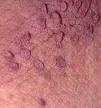
Skin Tag
What are skin tags?
A skin tag is a benign (non-cancerous) skin growth that can occur on the body or face. They can be are smooth or wrinkled, skin-colored or just slightly darker than skin color, and vary in size and can grow as large as a big grape.
Skin tags can occur almost anywhere there is skin but most commonly grow on the neck, underarms, eyelids, groin, upper chest, and under the breasts (especially where underwire bras rub directly beneath the breasts). Skin tags are typically thought to occur in characteristic locations where skin rubs against skin or clothing.
Skin tags on nape of neck.
What causes skin tags?
Skin tags are most common among obese people, and may be a sign of insulin resistance or pre-diabetes.
Approximately 50% of the entire population has or will have skin tags at sometime. They are more likely to appear as a person ages in middle-aged adulthood, an increase in frequency up to about age 60. It is also believed that friction from clothing may contribute to the growth of skin tags as they tend to grow most in areas where clothing and skin rub.
Skin tags can be a sign of insulin resistance. Â They may occur alone, in groups, and are often seen along with acanthosis nigricans (AN), a discoloration in patches of skin. There are many home “cures” and removal methods for skin tags, but because of the risk of bleeding and infection it is best to have them removed in your doctor’s office.
A cluster of skin tags.
Treatment for Skin Tags
Some people report that their skin tags disappear if they take chromium picolinate (200 mcg twice a day). This trace element may have positive impact on insulin resistance, one of the causes of skin tags. Chromium is a mineral and typically must be taken for 3 months to see the results.
Since chromium may impact blood glucose (sugar) and insulin sensitivity, talk with your doctor before taking this, or any other, supplement — especially if you are on insulin or anti-diabetic drugs.
Skin tags do not need treatment but if they become sore from rubbing against clothing or jewelry, or if you find them unsightly, they can be removed surgically.
There are several methods of removing skin tags:
- Cryosurgery (freezing) (see image on right);
- Tying off the stem to cut off the blood supply;
- Excision with scissors or a scalpel; and
- Burning with an electric needle
All of these methods of treatment are considered minor surgery, typically done in a doctor’s office. Since removal of skin tags is considered to be cosmetic, most health care systems and medical insurance plans will not cover it.
Babies are rarely born with skin tags, but children and toddlers sometimes develop skin tags in the underarm and neck areas. There is also wide belief that there is a genetic component involved in who will get skin tags, but this may be related to genes that contribute to insulin resistance rather than skin tags themselves.





